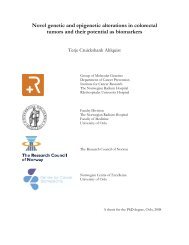Preface - Ous-research.no
Preface - Ous-research.no
Preface - Ous-research.no
You also want an ePaper? Increase the reach of your titles
YUMPU automatically turns print PDFs into web optimized ePapers that Google loves.
Surgical Intensive Care Medicine<br />
CLP, and Sham. Animals were sacrificed 18 hours after<br />
surgery. Studies in a unique long-term mouse model were<br />
conducted in collaboration with professors Heniz Redl and<br />
Soheyl Bahrami from the Ludwig Boltzmann Institute for<br />
Experimental and Clinical Traumatology, Vienna. Mice were<br />
divided in four groups and sacrificed at baseline or 18, 48, or<br />
96 hours following CLP.<br />
Figure 1. Tissue specific regulation of CCN2 mRNA expression in the<br />
livers, lungs and hearts of rats subjected to 18 hours of CLP.<br />
Expression levels of sham animals set to one. Relative ecpression levels<br />
in CLP animals displayed.<br />
Such stresses cause accumulation of unfolded proteins<br />
in the ER leading to a condition called ER stress. Protein<br />
aggregation is toxic for the cells and several pathological<br />
conditions are thus associated with ER stress. Adaption<br />
to altered environment and restoration of cell homeostasis<br />
involve cell protective mechanisms, Figure 3. Cellular<br />
responses to ER stress degrade misfolded proteins by the<br />
ubiquitin proteasome system in the cytoplasm, and regulate<br />
mRNA translation and assist protein folding by a pathway<br />
called unfolded protein response (UPR). The adaptive<br />
mechanisms during UPR are mediated through the three ER<br />
transmembrane receptors; pancreatic ER kinase (PKR)-like<br />
ER kinase (PERK), activating transcription factor 6 (ATF6) and<br />
i<strong>no</strong>sitol-requiring enzyme 1 (IRE1). Initial signalling through<br />
these receptors induces protein folding and degradation of<br />
ER-associated proteins and inhibits mRNA translation thereby<br />
reducing the influx of proteins to the ER. However, if ER<br />
stress is prolonged and the adaption fails, the signalling will<br />
become pro-apoptotic and the cell will go into programmed<br />
cell death, apoptosis.<br />
Figure 2. Time differential regulation of CCN1 and CCN3 mRNA<br />
expression in mice subjected to CLP for 0, 18, 48 or 96 hours. Expression<br />
levels standardized to 0 hour.<br />
Preliminary data shows both a tissue-specific (Figure 1) and<br />
time-differential regulation of CCN gene expression in the<br />
models (Figure 2).<br />
Furthermore, a specific gene expression profile during<br />
sepsis for single CCN genes in different organs has been<br />
documented.<br />
This provides <strong>no</strong>vel indications of involvement of the ECM<br />
associated CCN proteins in sepsis-induced organ failure.<br />
Endoplasmic reticulum (ER) stress and apoptosis – links to<br />
development of organ failure in sepsis<br />
The ER is the main site of protein modification and folding<br />
and is highly sensitive to stresses that alter the cellular<br />
energy level, the redox state or the Ca2+ concentration.<br />
Figure 3.: Cellular responses to Endoplasmatic Reticulum (ER) stress.<br />
Cellular responses to ER stress involve degradation of<br />
misfolded proteins by the ubiquitin proteasome system (1),<br />
induction of protein folding and inhibition of mRNA translation<br />
by the UPR, unfolded protein response (2) or can lead<br />
to apoptosis (3) if the stress is prolonged.<br />
Two previous studies report a possible role of prolonged<br />
ER stress in the development of organ dysfunction in septic<br />
animals. These studies show an increased expression of<br />
k<strong>no</strong>wn markers of ER stress in spleen of CLP-operated mice<br />
and in liver of LPS-treated rats. Initial data generated in<br />
our group show similar results in liver of CLP-operated rats<br />
10
















